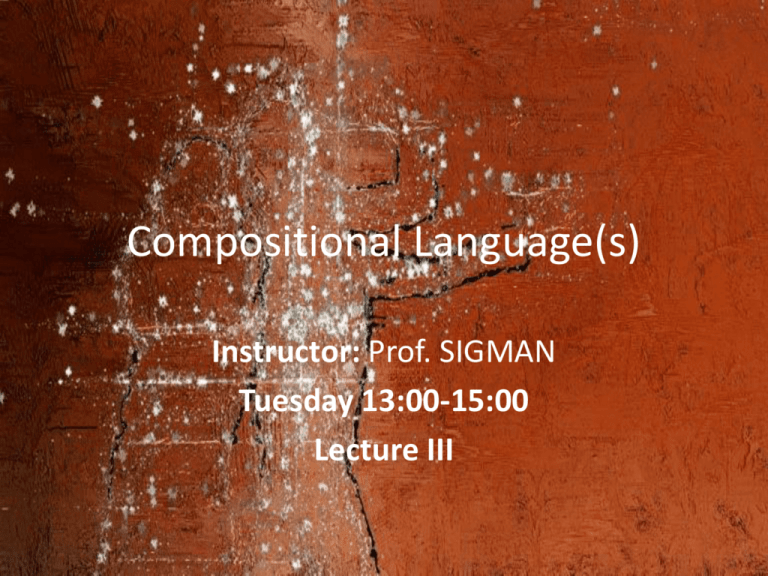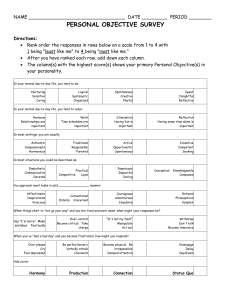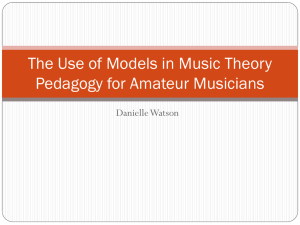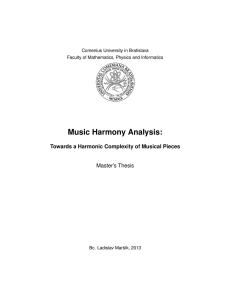DAT 335: Music Perception and Cognition
advertisement

Compositional Language(s) Instructor: Prof. SIGMAN Tuesday 13:00-15:00 Lecture III Announcements • Assignement I submission? • Course website: www.lxsigman.com/clgfall2012/index.htm • Missing email addresses!! 0. Review: Typical Musical Parameters • • • • • • • • • Pitch (고 저) Rhythm (Pulse/Meter) Melody Harmony (학 성) Dynamic Register Timbre (음 색) Texture (결) Orchestration I. The Harmony of the Spheres A. Pythagoras • Sun, Moon and Planets: emit resonances • Frequency = speed of revolutions • Musical ratios (비 율) B. Plato • Harmony of the soul’s proportions = harmony of the universe • (e.g.: Timaeus dialogue) C. Boethius (480-525 AD) • Musica mundana: music of the universe • Musica humana: music of the human body • Musica quae in quibusdam constituta est instrumentis: sounds made by singers (가수) and instrumentalists (역 주 자) • all in agreement with each other D. The Harmony of the Spheres: Realisation • http://www.youtube.com/watch?v=1EFZuzgcI zY • Harmonic series ratios (of Pythagoras and later Kepler) = ratios between 2+ sounding frequencies • 2+ frequencies sounding at the same time = harmony • Musica universalis = components of single tone and multiple resonating tones II. Common Practice Harmony A. The Common Practice Period • The period between ca. 1600-1900 is known (in English) as the common practice period. It is the period during which tonality (음 샘) was dominant in Western Europe • B. Definition of Tonality • Tonal harmony ≠ tertian (삼 일 열 ) harmony! • These pieces use triads, but NOT tonal syntax: • http://www.youtube.com/watch?v=XqdxtFJx4 7Q • http://www.youtube.com/watch?v=MuJLAZf5 nxE C. Tonal Syntax vs. Linguistic Syntax • Syntax (구 문 론) in natural language (언 어) = a set of rules (규 정) for ordering words (단 어)in a sentence based upon function (part of speech) (명 사, 동사, etc.) • Syntax in tonal harmony = a set of rules for ordering chords (한 음) based upon function • Rules allow for ambiguity (모호) D. Tonal Function Categories • Tonic • Dominant • Pre-Dominant E. Tonal Function Rules • 1) Tonic -> Anywhere • 2) Dominant -> Tonic; • 3) Pre-dominant -> Other Predominant; -> Dominant • E.g.: V-> IV-> I = retrogression = ILLEGAL! III. Analysis A. Inversions: Symbols and Reference • 1st inversion: “six-three” • 2nd inversion: “six-four” • Figured bass symbols B. Triad Qualities • • • • Major Minor Augmented Diminished C. Seventh Chord Qualities • • • • • Major Dominant Minor Half Diminished Fully Diminished Seventh Chord Inversions • • • • Root Position 1st Inversion 2nd Inversion 3rd Inversion D. Tonicisation • NOT modulation • Approached via secondary dominant • Return to original key, or continuation to new key areas • Context: Typical of sequences (일 련), episodes in fugues and sonata development sections • occurs on pivot (회 전 죽) chord (analysed in both original and new key) Pivot Example E. Modulation (조 장) • “in” a key • Longer time spent in new key than for tonicisation • Context: sonata exposition modulates from I/i-> new key • Occurs on pivot chord F. Cadences Phrygian VI-> V (in minor ONLY) Cadences: PAC vs. IAC III. Non-Chord Tones (NCT) • • • • • • • Passing tone (PT) Upper/lower neighbour (UN/LN) Suspension (SUS) Retardation (RET) Appoggiatura (APP) Echappée (escape tone) (ET) Anticipation A. Commonalities • All are dissonances (불협화음) • All resolve to chord tones • Types of ornamentation (장 식) B. Passing Tone C. Upper Neighbour/Lower Neighbour C. Suspension • • • • Preparation Suspension Resolution Resolves downwards Suspension Types • • • • 9-8 7-6 4-3 2-3 (BASS ONLY) Suspension Examples D Retardation • Suspension, but resolves upwards • Typically found at cadences in minor keys E. Appoggiatura • • • • Approached by leap (if unaccented) Approached by step (in accented Resolved by step Common ornamentation in Baroque and early Classical works F. Echappée (escape tone) • Approached by step • Resolved by leap • Inverse of appoggiatura G. Anticipation





